Preparation of Superhydrophobic Flame-Retardant UHMWPE Fabrics with Excellent Mechanical Stability by Simple Coating Method
Abstract
:1. Introduction
2. Experiment
2.1. Materials
2.2. Preparation of Flame-Retardant Coating Solution
2.3. Preparation of Hydrophobic Coating Solution
2.4. Preparation of UHMWPE Fabric Coating
2.5. Characterization
3. Results and Discussion
3.1. Surface Morphology and Chemical Structure
3.2. Flame Retardancy
3.3. Superhydrophobicity and Self-Cleaning Performance
3.4. Breathability Performance
3.5. Mechanical Performance
3.6. Adhesion Enhancement Mechanism
4. Conclusions
Author Contributions
Funding
Institutional Review Board Statement
Informed Consent Statement
Data Availability Statement
Conflicts of Interest
References
- Lin, J.; Li, Y.; Fan, H. Anti-ballistic properties of hybrid UHMWPE fiber-reinforced composite armour. Compos. Sci. Technol. 2025, 259, 110941. [Google Scholar]
- Xu, R.; Lu, S.; Miao, J.; Tang, C.; Yu, J. Fiber-reinforced gypsum composites with ultra-high ductility: Investigation of physical and mechanical properties. Constr. Build. Mater. 2024, 457, 139285. [Google Scholar]
- Yu, J.; Chen, H.; Huang, H.; Zeng, M.; Qin, J.; Liu, H.; Ji, M.; Bao, F.; Zhu, C.; Xu, J. Protein-induced decoration of applying MXene directly to UHMWPE fibers and fabrics for improved adhesion properties and electronic textiles. Compos. Sci. Technol. 2022, 218, 109158. [Google Scholar]
- Cha, J.H.; Kumar, S.K.S.; Noh, J.E.; Choi, J.S.; Kim, Y.; Kim, C.G. Ultra-high-molecular-weight polyethylene/hydrogen-rich benzoxazine composite with improved interlaminar shear strength for cosmic radiation shielding and space environment applications. Compos. Struct. 2022, 300, 116157. [Google Scholar]
- Liu, H.; Zhang, H.; Yu, X.; Xu, Z.; Cui, J.; Lai, M.; Yu, J.; Bao, F.; Tang, Z.; Zhu, C.; et al. Flexible, lightweight, high strength and high efficiently hierarchical Gd2O3/PE composites based on the UHMWPE fibers with self-reinforcing strategy for thermal neutron shielding. Compos. Sci. Technol. 2024, 251, 110549. [Google Scholar]
- Marquis, C.; Song, R.; Waddell, S.; Luong, A.; Arola, D. Additive manufacturing with continuous ultra-high molecular weight polyethylene yarn. Mater. Des. 2023, 235, 112411. [Google Scholar]
- Chhetri, S.; Bougherara, H. A comprehensive review on surface modification of UHMWPE fiber and interfacial properties. Compos. Part A Appl. Sci. Manuf. 2021, 140, 106146. [Google Scholar]
- Wang, S.; Ma, J.; Feng, X.; Cheng, J.; Ma, X.; Zhao, Y.; Chen, L. An effective surface modification of UHMWPE fiber for improving the interfacial adhesion of epoxy resin composites. Polym. Compos. 2020, 41, 1614–1623. [Google Scholar]
- Fang, Z.; Tu, Q.; Shen, X.; Yang, X.; Liang, K.; Pan, M.; Chen, Z. Biomimetic surface modification of UHMWPE fibers to enhance interfacial adhesion with rubber matrix via constructing polydopamine functionalization platform and then depositing zinc oxide nanoparticles. Surf. Interfaces 2022, 29, 101728. [Google Scholar]
- Shelly, D.; Nanda, T.; Mehta, R. Addition of compatibilized nanoclay and UHMWPE fibers to epoxy based GFRPs for improved mechanical properties. Compos. Part A Appl. Sci. Manuf. 2021, 145, 106371. [Google Scholar]
- Hu, S.; Yuan, X.; Ma, Y.; Zhang, G.; Wang, C.; Pang, X.; Xiong, F. Temperature-influenced cutting mechanism of UHMWPE fibres. J. Manuf. Process. 2024, 113, 183–196. [Google Scholar]
- Cheng, B.; Duan, H.; Chen, S.; Shang, H.; Li, J.; Shao, T. Effects of thermal aging on the blend phase morphology and tribological performance of PI/UHMWPE blend composites. Wear 2021, 477, 203840. [Google Scholar] [CrossRef]
- Lau, S.; Gonchikzhapov, M.; Paletsky, A.; Shmakov, A.; Korobeinichev, O.; Kasper, T.; Atakan, B. Aluminum diethylphosphinate as a flame retardant for polyethylene: Investigation of the pyrolysis and combustion behavior of PE/AlPi-Mixtures. Combust. Flame 2022, 240, 112006. [Google Scholar]
- Liu, X.; Shao, Q.; Cao, J.; Du, Z.; Yu, W. Superamphiphobic and flame-resistant cotton fabrics for protective clothing. Cellulose 2022, 29, 619–632. [Google Scholar]
- Cheng, X.W.; Liu, Y.W.; Jin, J.H.; Guan, J.P.; Chen, R. Metallic phytates modified polyurethane coating for constructing long-lasting flame-retardant outdoor polyester fabric. Prog. Org. Coat. 2024, 188, 108205. [Google Scholar]
- Miao, Z.; Yan, D.; Zhang, T.; Yang, F.; Zhang, S.; Liu, W.; Wu, Z. High-efficiency flame retardants of a P–N-Rich polyphosphazene elastomer nanocoating on cotton fabric. ACS Appl. Mater. Interfaces 2021, 13, 32094–32105. [Google Scholar]
- Li, N.; Kang, G.; Liu, H.; Qiu, W.; Wang, Q.; Liu, L.; Wang, X.; Yu, J.; Li, F.; Wu, D. Fabrication of eco-friendly and efficient flame retardant modified cellulose with antibacterial property. J. Colloid Interface Sci. 2022, 618, 462–474. [Google Scholar]
- Zhang, A.-N.; Zhao, H.-B.; Cheng, J.-B.; Li, M.-E.; Li, S.-L.; Cao, M.; Wang, Y.-Z. Construction of durable eco-friendly biomass-based flame-retardant coating for cotton fabrics. Chem. Eng. J. 2021, 410, 128361. [Google Scholar]
- Cheng, X.W.; Dong, S.; Yang, H.J.; Zhao, L.P.; Guan, J.P. The development of phosphorus-doped hybrid silica sol coating for silk with durable flame retardancy. Polym. Degrad. Stab. 2022, 201, 109974. [Google Scholar]
- Liu, L.; Ma, Z.; Zhu, M.; Liu, L.; Dai, J.; Shi, Y.; Gao, J.; Dinh, T.; Nguyen, T.; Tang, L.-C.; et al. Superhydrophobic self-extinguishing cotton fabrics for electromagnetic interference shielding and human motion detection. J. Mater. Sci. Technol. 2023, 132, 59–68. [Google Scholar]
- Li, N.; Han, H.; Li, M.; Qiu, W.; Wang, Q.; Qi, X.; He, Y.; Wang, X.; Liu, L.; Yu, J.; et al. Eco-friendly and intrinsic nanogels for durable flame retardant and antibacterial properties. Chem. Eng. J. 2021, 415, 129008. [Google Scholar] [CrossRef]
- Lau, S.; Atakan, B. Isothermal pyrolysis investigation of aluminum diethylphosphinate mixed as a flame retardant additive into ultra-high molecular weight polyethylene. Combust. Flame 2020, 222, 272–284. [Google Scholar] [CrossRef]
- Korobeinichev, O.; Gonchikzhapov, M.; Paletsky, A.; Tereshchenko, A.; Shundrina, I.; Kuibida, L.; Shmakov, A.; Hu, Y. Counterflow flames of ultrahigh-molecular-weight polyethylene with and without triphenylphosphate. Combust. Flame 2016, 169, 261–271. [Google Scholar] [CrossRef]
- Wang, H.; Cao, J.; Luo, F.; Cao, C.; Qian, Q.; Huang, B.; Xiao, L.; Chen, Q. Simultaneously enhanced mechanical properties and flame retardancy of UHMWPE with polydopamine-coated expandable graphite. RSC Adv. 2019, 9, 21371–21380. [Google Scholar] [CrossRef] [PubMed]
- Shen, L.; Li, J.; Lin, H.; Feng, S.; Zhang, Y. The enhanced compatibility and flame retarding ability of UHMWPE-MH composites by adding phenoxycyclophosphazene (HPCTP). Polym. Bull. 2017, 74, 3639–3655. [Google Scholar] [CrossRef]
- Sun, R.Y.; Wang, F.; Li, C.B.; Deng, Z.P.; Song, F.; Wang, Y.Z. Formulation of environmentally robust flame-retardant and superhydrophobic coatings for wood materials. Constr. Build. Mater. 2023, 392, 131873. [Google Scholar] [CrossRef]
- Chen, S.; Li, X.; Zhang, C.; Long, L.; Zhao, X.; Zhu, C.; Li, B.; Yi, X. Superhydrophobic nanocellulose aerogel for thermal insulation and thermal resistance up to 1300 °C. Chem. Eng. J. 2024, 499, 156043. [Google Scholar] [CrossRef]
- Wu, S.; Chen, D.; Zhao, G.; Cheng, Y.; Sun, B.; Yan, X.; Han, W.; Chen, G.; Zhang, X. Controllable synthesis of a robust sucrose-derived bio-carbon foam with 3D hierarchical porous structure for thermal insulation, flame retardancy and oil absorption. Chem. Eng. J. 2022, 434, 134514. [Google Scholar] [CrossRef]
- Zang, X.; Bian, J.; Ni, Y.; Zheng, W.; Zhu, T.; Chen, Z.; Cao, X.; Huang, J.; Lai, Y.; Lin, Z. A robust biomimetic superhydrophobic coating with superior mechanical durability and chemical stability for inner pipeline protection. Adv. Sci. 2024, 11, 2305839. [Google Scholar] [CrossRef]
- Zhao, Z.; Sun, S.; Li, C.; Hu, S. In situ growth of micro-nano structured black oxide coating on steel with excellent superhydrophobicity and corrosion resistance. Compos. Struct. 2024, 344, 118338. [Google Scholar] [CrossRef]
- Deng, H.; Guo, L.; Chen, K.; You, P.; Zhang, P.; Xu, Y.; Song, N.; Tian, C.; Wang, J.; Liang, S. End group capturing in polyurea elastomer by using aromatic dianhydrides for flame retardance. Compos. Part B Eng. 2024, 274, 111276. [Google Scholar]
- Xavier, J.R.; Vinodhini, S.P. Improved anticorrosion, flame retardant and mechanical behaviors of multifunctional polyurethane nanocomposite coatings for industrial applications. Polym. Degrad. Stab. 2023, 213, 110370. [Google Scholar]
- Yang, S.; Chen, L.; Wang, S.; Liu, S.; Xu, Q.; Zhu, J.; Zhang, Q.; Zhao, P. Honeycomb-like cobalt hydroxide nanosheets induced basalt fiber fabrics with robust and durable superhydrophobicity for anti-icing and oil-water separation. J. Hazard. Mater. 2022, 429, 128284. [Google Scholar]
- Shao, J.; Sheng, W.; Wang, C.; Ye, Y. Solvent-free fabrication of tough self-crosslinkable short-fluorinated copolymer nanocoatings for ultradurable superhydrophobic fabrics. Chem. Eng. J. 2021, 416, 128043. [Google Scholar]
- He, Q.; Wang, J.; Wang, G.; Hao, X.; Li, A. Construction of a durable superhydrophobic flame-retardant coating on the PET fabrics. Mater. Des. 2023, 233, 112258. [Google Scholar]
- Huang, J.; Li, M.; Ren, C.; Huang, W.; Wu, Q.; Li, Q.; Zhang, W.; Wang, S. Preparation of high-efficiency flame-retardant and superhydrophobic cotton fabric by a multi-step dipping. Coatings 2021, 11, 1147. [Google Scholar] [CrossRef]
- Li, C.; Song, J.; Xing, W.; Wang, L.; Cui, Y.; Pei, X. Mechanical properties of interlayer hybrid textile composite materials based on modified aramid and UHMWPE fabrics. Polym. Adv. Technol. 2023, 34, 205–216. [Google Scholar]
- Gao, M.; Wang, Y.; Zhang, Y.; Li, Y.; Tang, Y.; Huang, Y. Deposition of thin films on glass fiber fabrics by atmospheric pressure plasma jet. Surf. Coat. Technol. 2020, 404, 126498. [Google Scholar]
- Palaskar, S.S. Adhesion studies of atmospheric pressure plasma-modified polyester fabrics with polyurethane coating. J. Adhes. Sci. Technol. 2023, 37, 3468–3484. [Google Scholar]
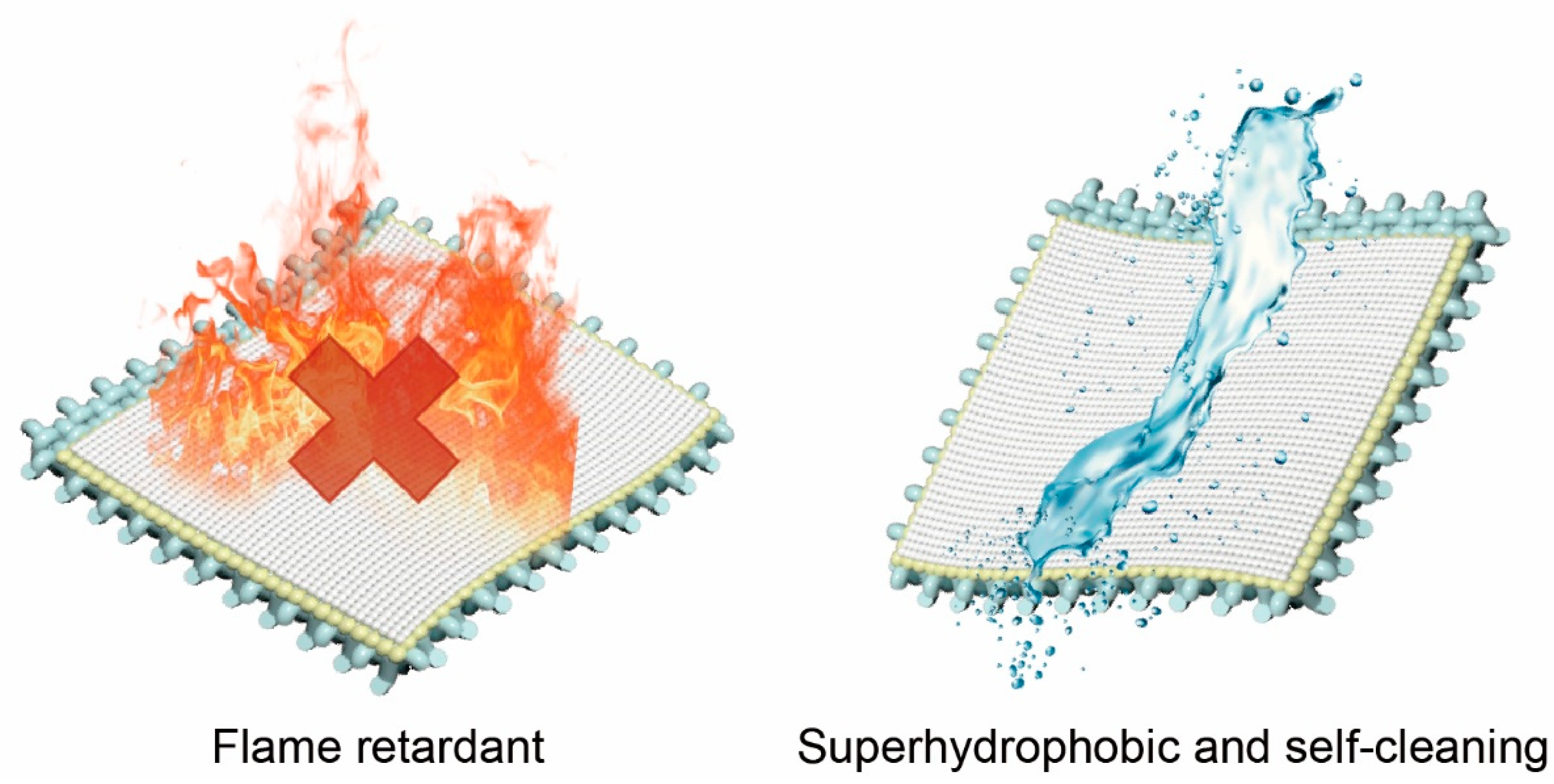
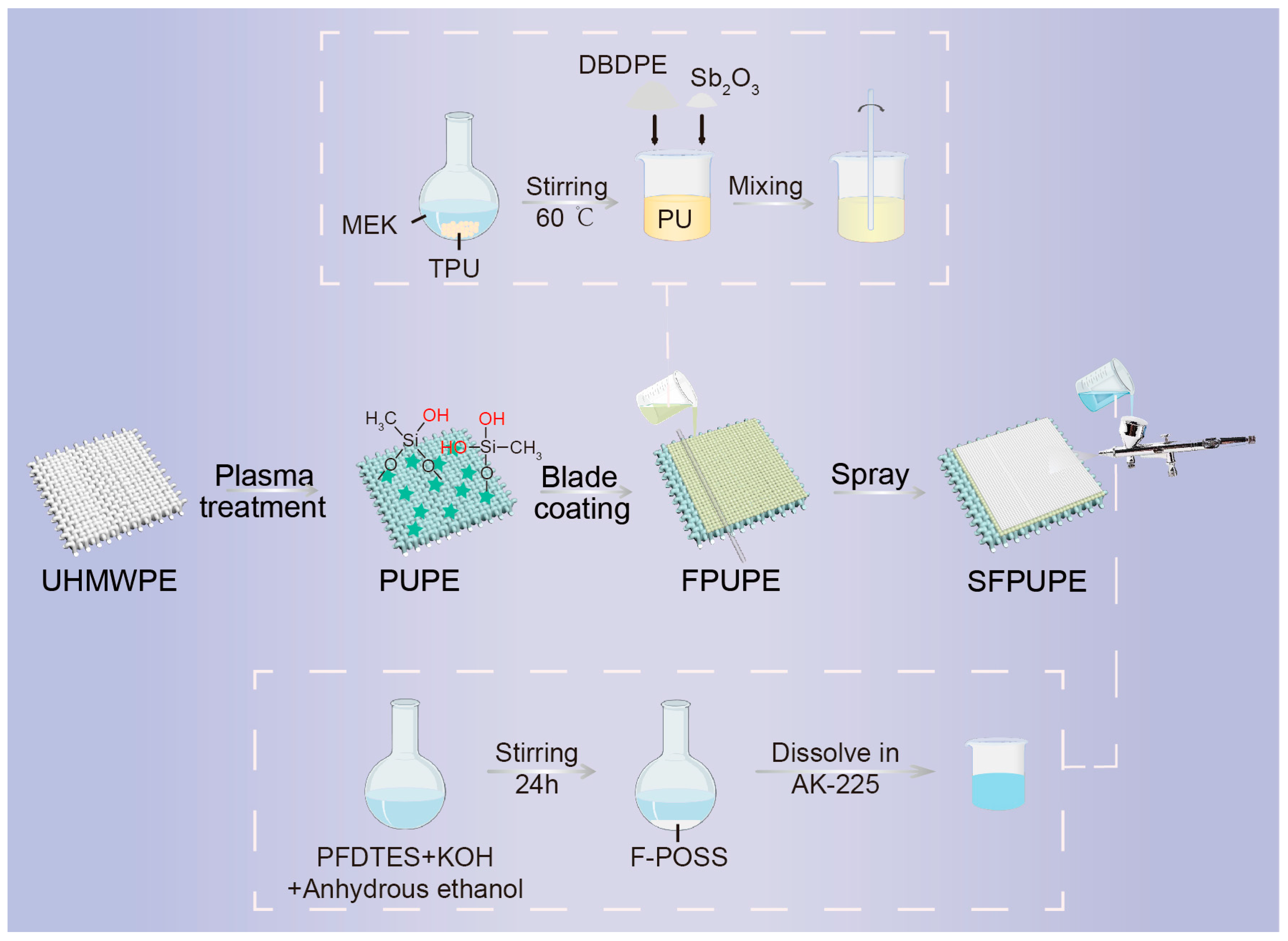

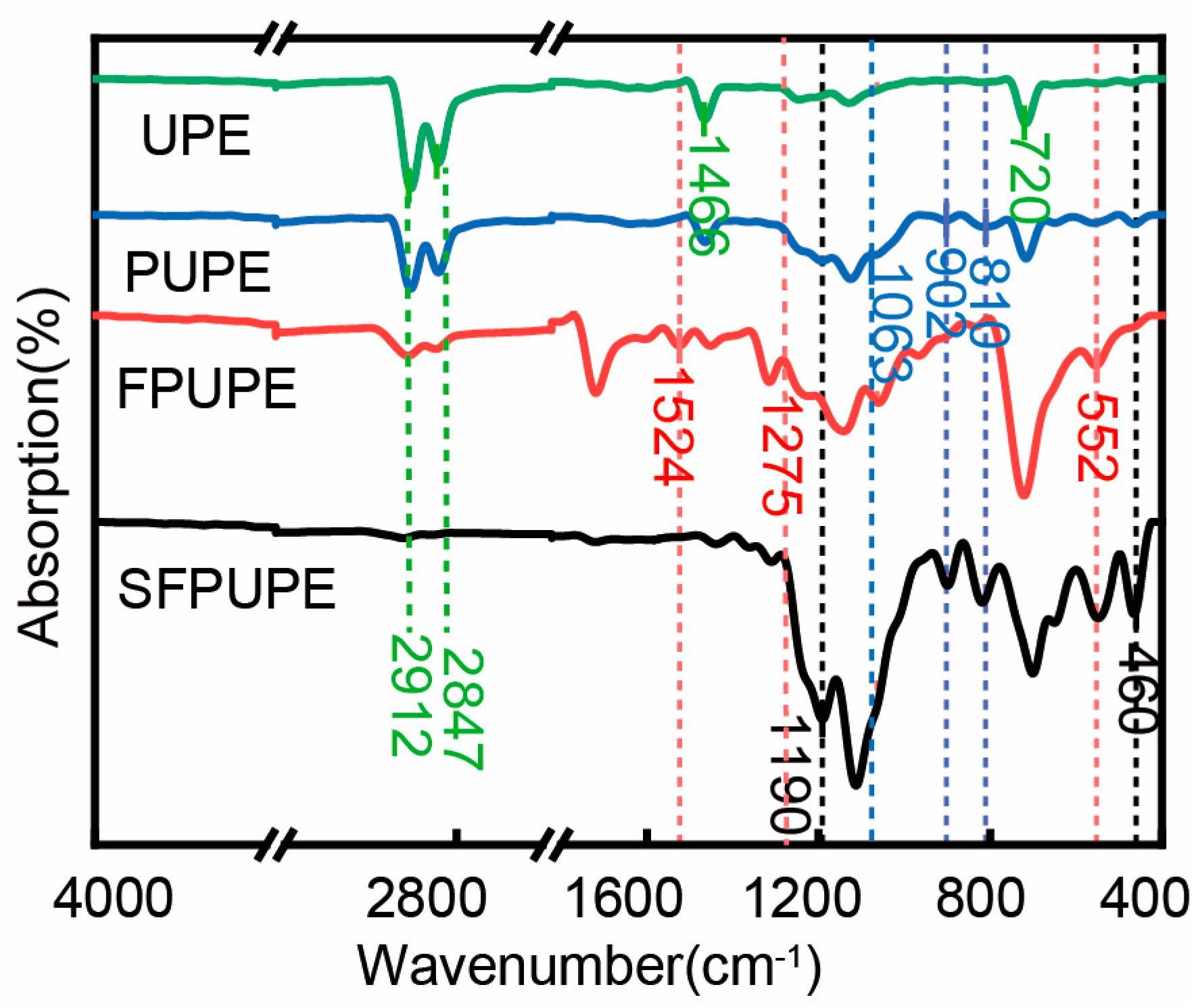
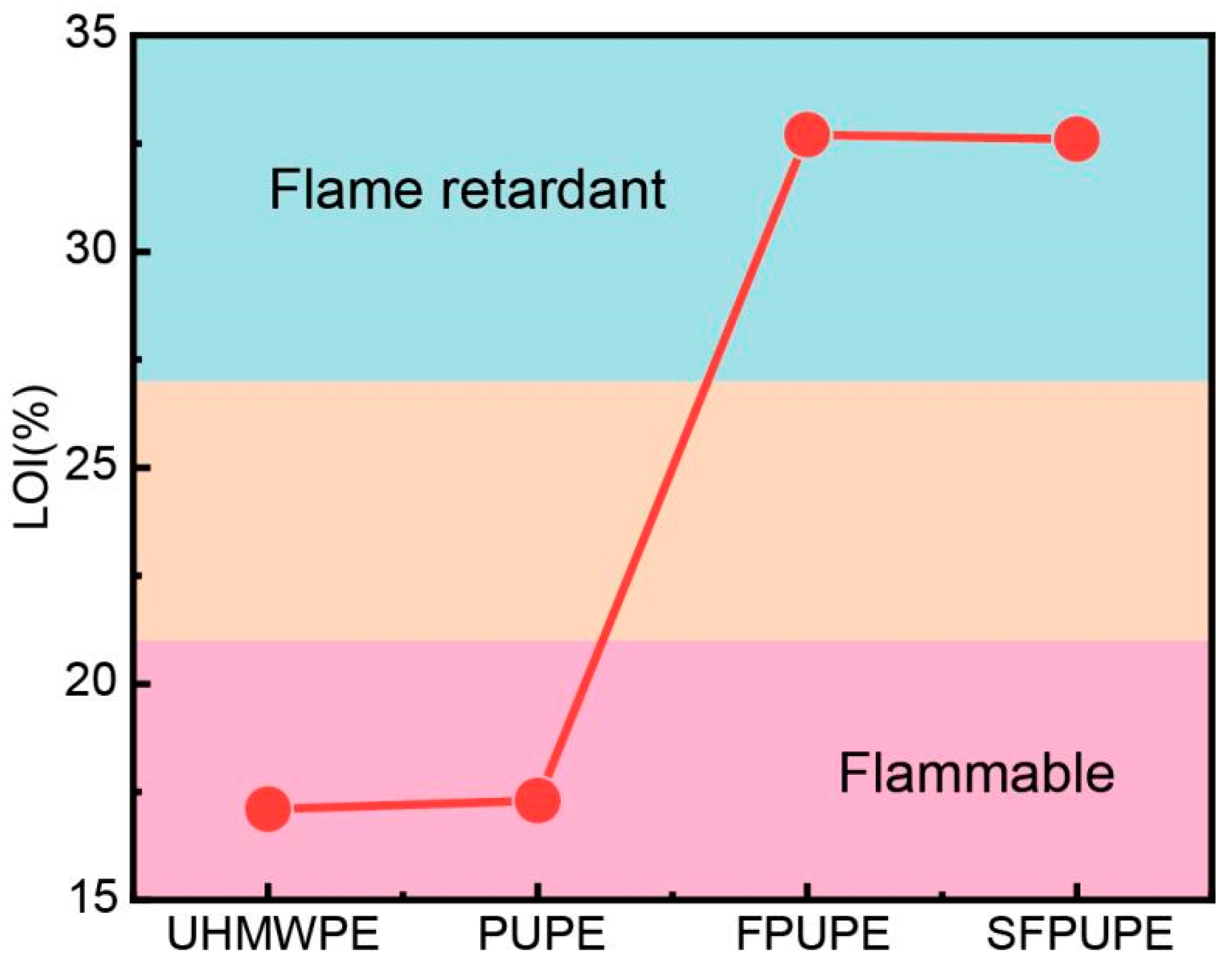
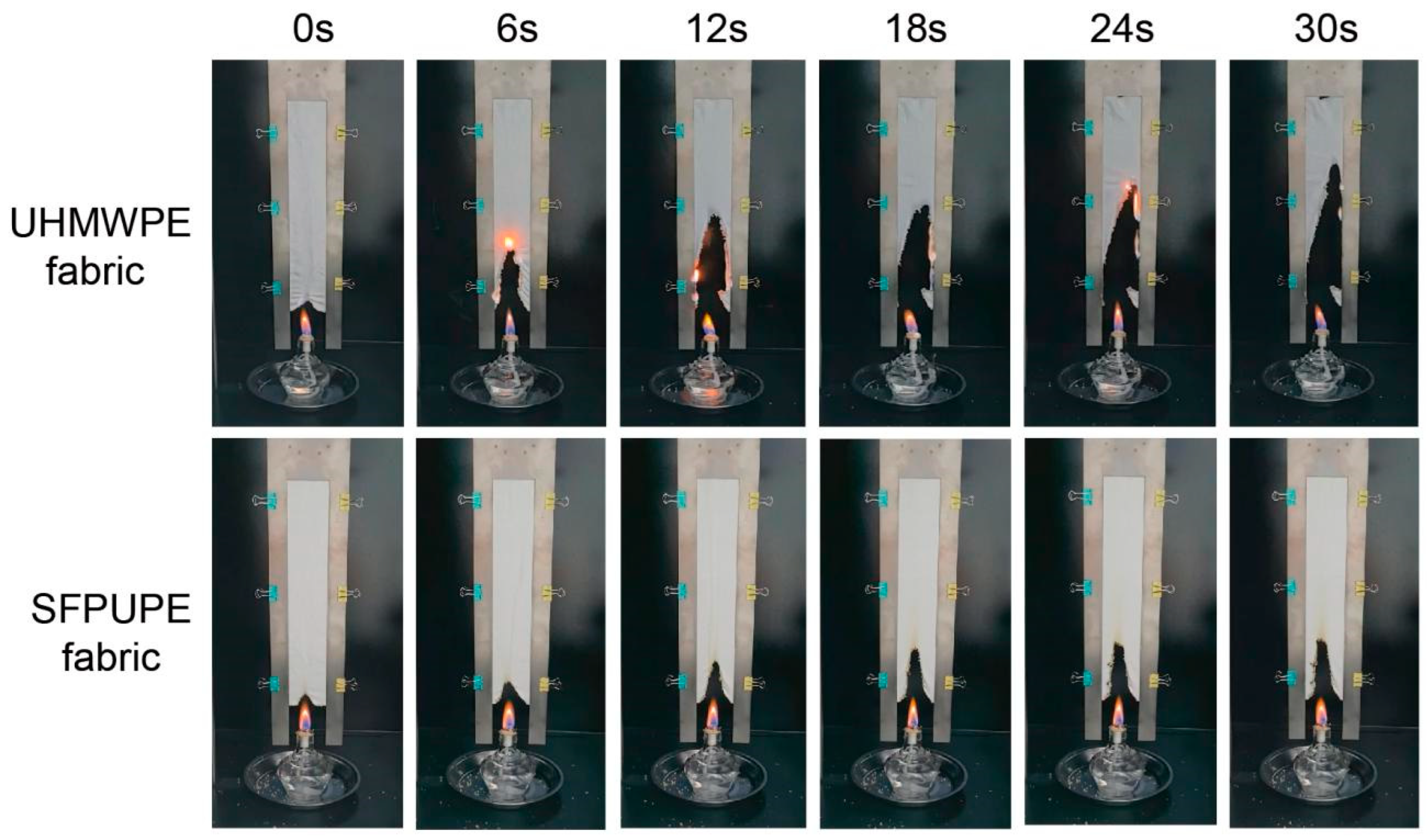
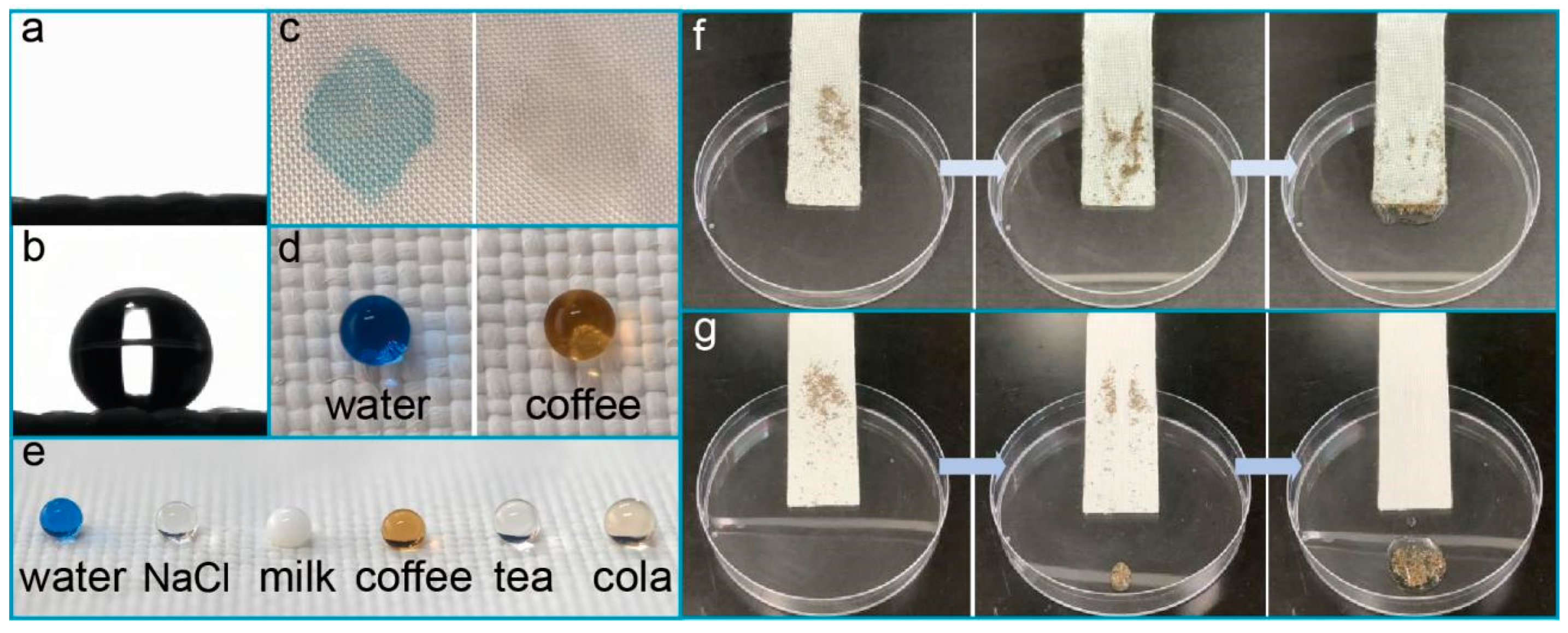
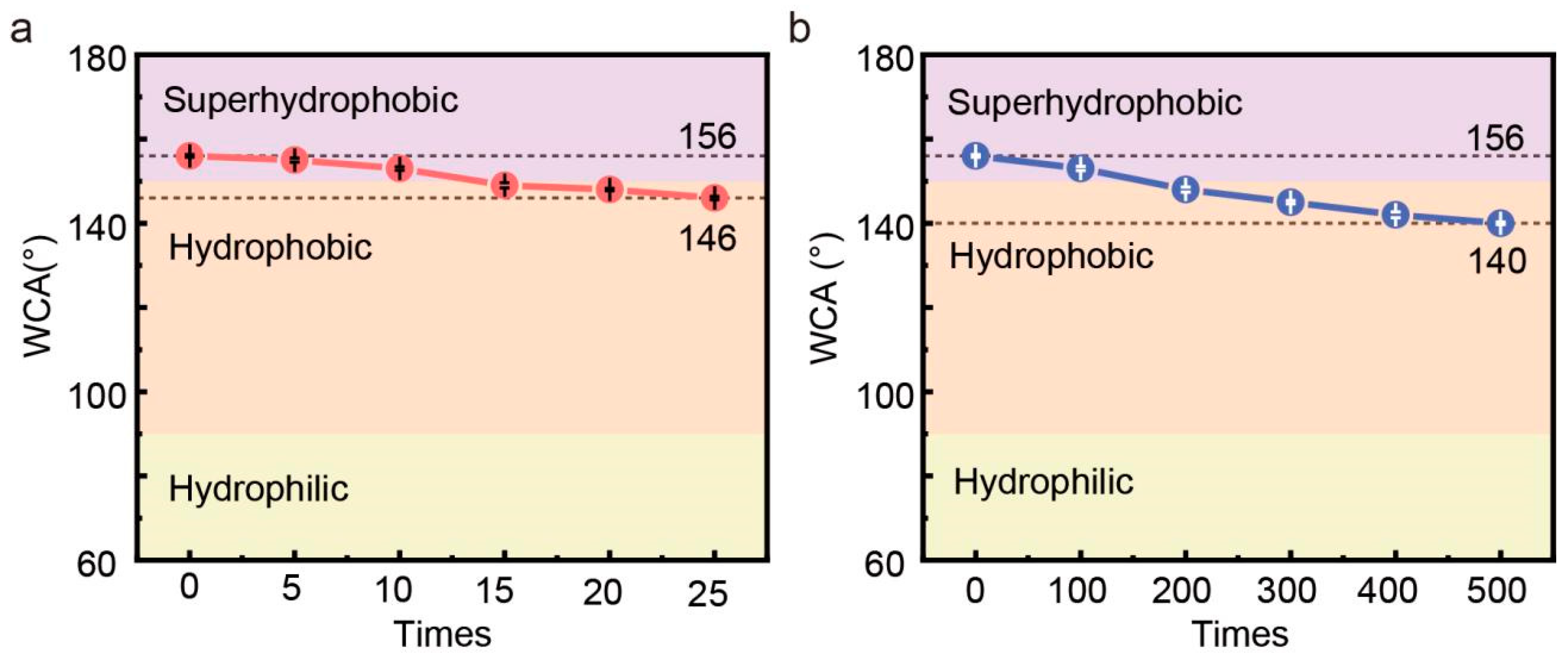
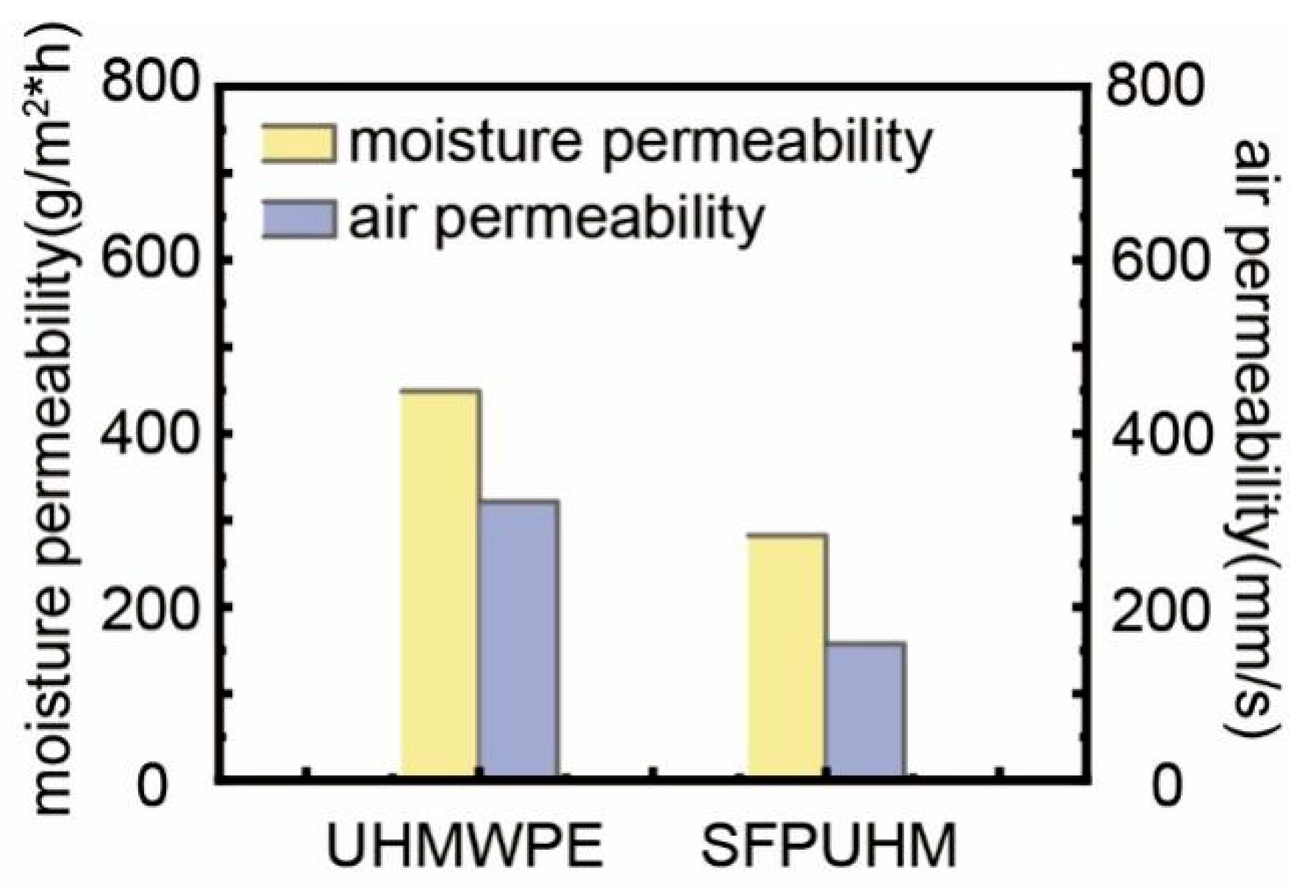


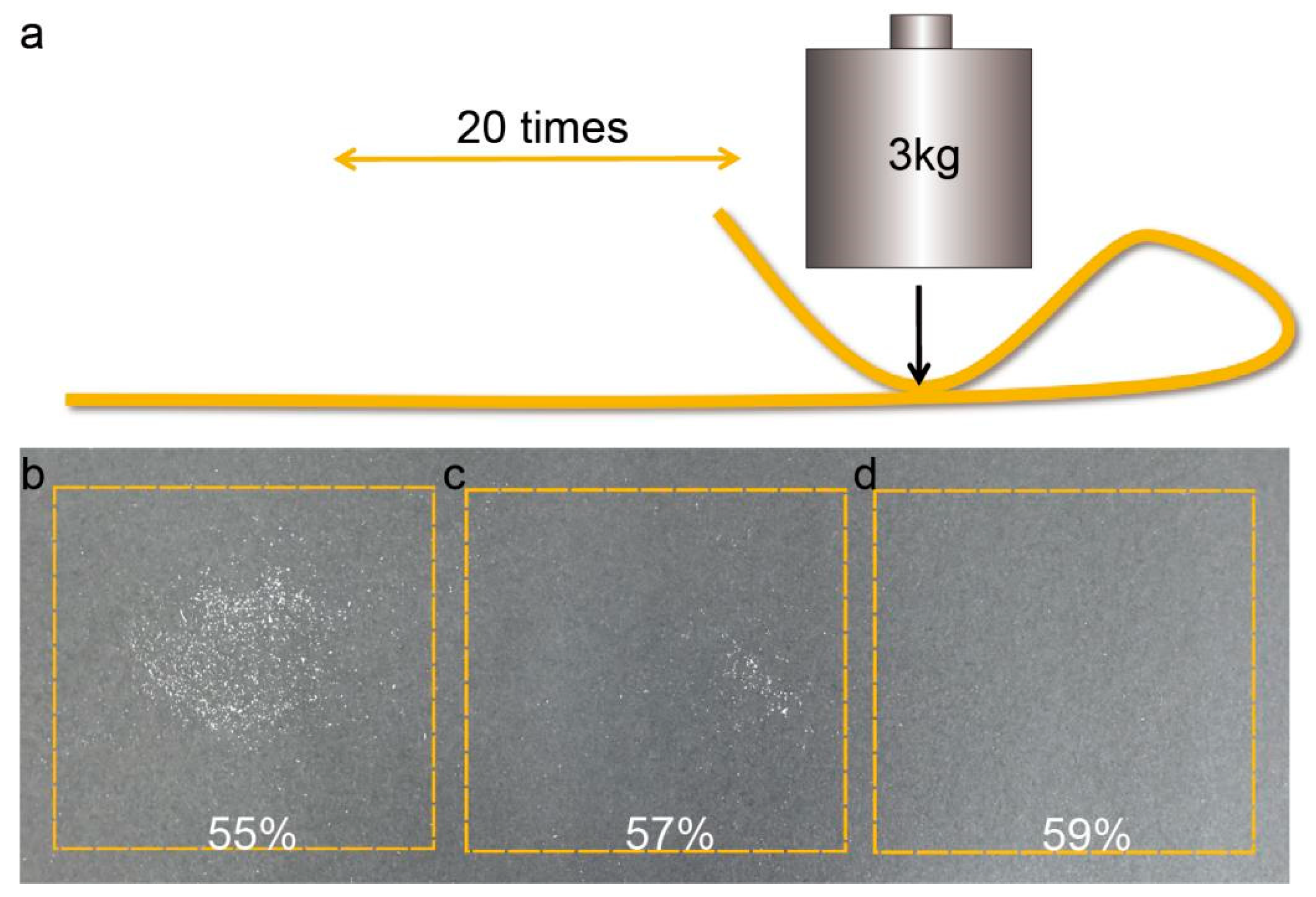
Disclaimer/Publisher’s Note: The statements, opinions and data contained in all publications are solely those of the individual author(s) and contributor(s) and not of MDPI and/or the editor(s). MDPI and/or the editor(s) disclaim responsibility for any injury to people or property resulting from any ideas, methods, instructions or products referred to in the content. |
© 2025 by the authors. Licensee MDPI, Basel, Switzerland. This article is an open access article distributed under the terms and conditions of the Creative Commons Attribution (CC BY) license (https://creativecommons.org/licenses/by/4.0/).
Share and Cite
Saitaer, X.; Wang, J.; Gao, Q.; Li, Y.; Sun, J.; Cao, J.; Wang, Y.; Liu, Z.; Liu, X. Preparation of Superhydrophobic Flame-Retardant UHMWPE Fabrics with Excellent Mechanical Stability by Simple Coating Method. Coatings 2025, 15, 366. https://doi.org/10.3390/coatings15040366
Saitaer X, Wang J, Gao Q, Li Y, Sun J, Cao J, Wang Y, Liu Z, Liu X. Preparation of Superhydrophobic Flame-Retardant UHMWPE Fabrics with Excellent Mechanical Stability by Simple Coating Method. Coatings. 2025; 15(4):366. https://doi.org/10.3390/coatings15040366
Chicago/Turabian StyleSaitaer, Xiakeer, Jianing Wang, Qiang Gao, Ying Li, Jiahao Sun, Jiqiang Cao, Ying Wang, Zengying Liu, and Xiang Liu. 2025. "Preparation of Superhydrophobic Flame-Retardant UHMWPE Fabrics with Excellent Mechanical Stability by Simple Coating Method" Coatings 15, no. 4: 366. https://doi.org/10.3390/coatings15040366
APA StyleSaitaer, X., Wang, J., Gao, Q., Li, Y., Sun, J., Cao, J., Wang, Y., Liu, Z., & Liu, X. (2025). Preparation of Superhydrophobic Flame-Retardant UHMWPE Fabrics with Excellent Mechanical Stability by Simple Coating Method. Coatings, 15(4), 366. https://doi.org/10.3390/coatings15040366






